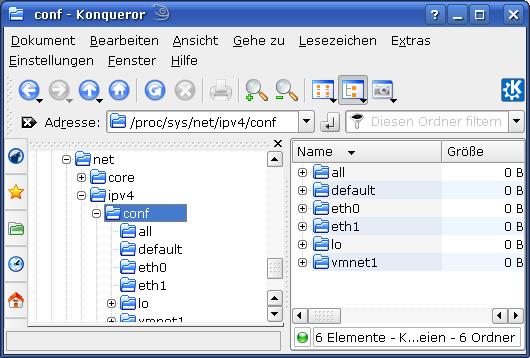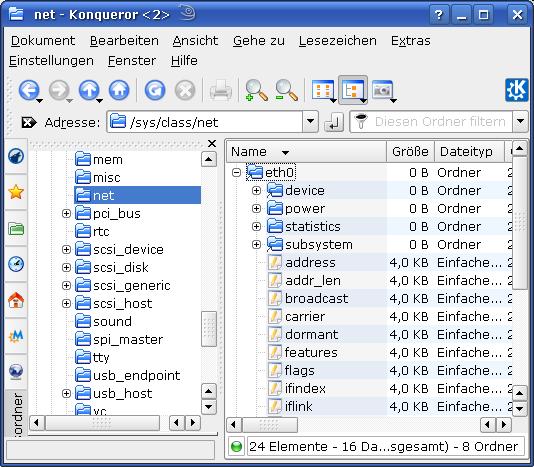Vor kurzem habe ich ca. 2 Stunden damit verbracht, mich mit einem vermutlichen Fehler in der Samba-Server-Version 3.2.7 unter Kernel 2.6.27 herumzuschlagen. (Die Kernelversion galt sowohl für den betroffenen Server wie auch die Linux-Clients).
Der Fehler bestand darin, dass “force create mode” und “force directory mode” Einstellungen des Samba-Servers ignoriert wurden, wenn User von unseren Linux-Clients aus Dateien/Verzeichnisse im Share anlegen wollten. Das hatte bei uns in der Praxis insofern Folgen, als die reibungslose Arbeit in der Gruppe u.a. von den Rechten der erzeugten Dateien abhing.
Die “force…”-Einstellungen waren gerade deshalb gesetzt worden, damit weder Windows- noch Linux-User der Samba-Shares über die Rechte-Einstellungen nachdenken mussten.
Das Problem im Detail und die Bedeutung der “unix extensions”
Ich habe für einen Share auf einem Samba-Server folgende Einstellungen vorgegeben:
[aux]
comment = aux
inherit acls = Yes
path = /samba/ann_aux
read only = No
create mask = 0664
force create mode = 0664
force user = myuser
Dieser Share wird in unserem Netz – wie gesagt – nicht nur von Win-XP Clients (natürlich in einer virtuellen Umgebung unter Linux) aus benutzt, sondern auch von Anwendern auf reinen Linux-Systemen. Dabei stellten wir dann fest, dass für einen berechtigten Linux-User zwar die “force user”-Vorgabe ausgeführt wurde, die Dateirechte jedoch immer auf “rw-,r–,r–“ gesetzt wurden, statt wie erwartet (“OR” – Kombination der Berechtigungs-Bits!) auf “rw-,rw-,r–“.
Der Rechtekamm “rw-,r–,r–“ entsprach nicht den “force create mode”-Einstellungen des Servers, sondern vielmehr den umask-Einstellungen für den betreffenden User auf dem Linux-Client.
Dagegen funktionierten die obigen Einstellungen auf einem deutlich älteren Samba-Server für ein anderes Share. Was also war der Unterschied zwischen den Servern? Nach einigem Suchen im Internet und Vergleichen kam ich dann dahinter, dass die Option “unix extensions” auf dem neueren Server gesetzt ist – defaultmäßig auf “yes”.
Dieser Parameter steuert für CIFS Shares die Anzeige und Nutzung von Linux-Rechten im Zusammenspiel zwischen Samba-Servern und Linux/Unix-Clients. Ich zitiere von “http://wiki.ubuntuusers.de/Samba_Server/smb.conf” :
CIFS Unix Extensionsunix extensions = yes
Dieser Parameter ermöglicht durch z.B. Samba Client/cifs auch auf dem Client die Original Dateirechte und Zeitstempel zu sehen und zu verwenden. Standardmäßig ist diese Option aktiviert; sie sollte nur bei Problemen mit diesen Extensions deaktiviert werden.
Die Einstellung kann nur für den gesamten Server geändert werden; unterschiedliche Einstellungen für einzelne Freigaben sind vom Server aus nicht möglich.
Dieser Parameter ermöglicht durch z.B. Samba Client/cifs auch auf dem Client die Original Dateirechte und Zeitstempel zu sehen und zu verwenden. Standardmäßig ist diese Option aktiviert; sie sollte nur bei Problemen mit diesen Extensions deaktiviert werden.
Die Einstellung kann nur für den gesamten Server geändert werden; unterschiedliche Einstellungen für einzelne Freigaben sind vom Server aus nicht möglich.
Weiter findet man unter “http://wiki.ubuntuusers.de/Samba_Client_cifs” folgende Ausführungen
Sind die CIFS-UNIX-Erweiterungen aktiv (auf dem Samba-Server: unix extensions = yes, Standard), so werden die echten Besitz- und
Zugriffsrechte zwischen Server und Client übertragen. Ändert man auf dem Client mittels chmod oder chown oder über den Eigenschaften-Dialog der GUI die Rechte, ist die Änderung ebenso auch auf dem Server und auf allen anderen Clients wirksam, die auf die Freigabe zugreifen.
Die Angaben in der Datei /etc/samba/smb.conf auf dem Server legen dabei den Rahmen fest, in dem Zugriffsrechte auf dem Client Gültigkeit haben. Ist z.B. eine Freigabe in smb.conf nur zum Lesen freigegeben, können für sie von keinem Client aus Schreibrechte festgelegt werden. Ist sie aber in smb.conf auch für Schreibzugriffe freigegeben, kann sie von jedem Client aus mittels chmod für “nur lesen” eingeschränkt werden. Ebenso können Freigaben, die auf dem Server den Status “nur lesen” haben, aber in smb.conf mit Schreibrechten eingetragen sind, vom Client aus mit Schreibrechten versehen werden.
Die UNIX-Erweiterungen haben Vorrang vor anderen Angaben für Besitz- und Zugriffsrechte. Sollten in der Mount-Befehlszeile oder im Eintrag in /etc/fstab solche Angaben vorhanden sein, so werden diese bei aktiven UNIX-Erweiterungen ignoriert.
Unter “http://us1.samba.org/samba/docs/man/manpages-3/smb.conf.5.html” liest man
unix extensions (G)
This boolean parameter controls whether Samba implements the CIFS UNIX extensions, as defined by HP. These extensions enable Samba to better serve UNIX CIFS clients by supporting features such as symbolic links, hard links, etc… These extensions require a similarly enabled client, and are of no current use to Windows clients.
Default: unix extensions = yes
Für Interessierte erwähne ich auch noch, dass auf dem Linux-Client beim Mounten eines CIFS-Shares auch ein Kernel-Parameter zur Nutzung der “unix extensions” gesetzt wird (bzw. gesetzt werden kann). Man werfe dazu nach dem Mounten des Samba-Shares einen Blick in das Verzeichnis “/proc/fs/cifs” und dort in die Datei “/proc/fs/cifs/LinuxExtensionsEnabled”. Ein
echo 0 > /proc/fs/cifs/LinuxExtensionsEnabled
schaltet auf dem Client die Nutzung der vom Samba-Server angebotenen Unix-Extensions ab.
Soviel zur Theorie. Tatsächlich funktionieren die “Unix extensions” im Prinzip auch so wie vorgesehen – wenn man mal das “force create mode” außer Acht läßt :
- Die User- und Gruppenrechte auf dem Samba-Server werden auf dem Linux-Client korrekt angezeigt. (Natürlich müssen auf dem Server und dem Client die gleichen UIDs und GIDs gesetzt sein wie auf dem Linux-Client!).
- Jede Rechteänderung auf dem Linux-Client wird auf den Server übertragen.
- Auch von MS Win-Clients aus funktioniert alles so wie vorgesehen – sogar das “force create mode” wird hier richtig ausgeführt.
Mein Problem besteht/bestand also darin, dass bei aktivierten “unix extensions” auf dem Samba-Server das gesetzte “force create mode” ignoriert wird, wenn man Dateien des Shares über einen Linux-Client anlegt. Das hätte ich schon aus Konsistenzgründen zu älteren Versionen des Samba-Servers nicht unbedingt so erwartet.
Die (vorrübergehende) Lösung
Probeweise habe ich den Samba-Server-Parameter “unix extensions” dann auf “no” gesetzt.
Danach wurden die Rechte von Files, die von Linux-Clients neu erzeugt wurden, tatsächlich wieder “korrekt” – d.h. gemäß der “force create mode”-Vorgaben – gesetzt. (Das Gleiche funktioniert natürlich auch, wenn man die entsprechenden Paramter für den Rechtemodus von Verzeichnissen benutzt.)
Blöd ist nur, dass die gewünschten und korrekt gesetzten User- und Gruppen-Rechte der Dateien auf dem Samba-Server nun natürlich nicht mehr auf den Linux-Clients angezeigt werden. Das war ja eigentlich der Sinn der “unix
extensions”. Aber damit kann man leben, wenn einem das Erzwingen von Rechten wirklich wichtig ist.
Eine Philosophie-Frage oder ein Bug ?
Nach diesen Erkenntnissen fragt man sich nun: Ist das eigentlich ein Bug ? Ich habe dazu zumindest einen Hinweis im Internet gefunden:
http://www.mail-archive.com/samba@lists.samba.org/msg99935.html und
http://www.mail-archive.com/samba@lists.samba.org/msg99936.html.
Natürlich könnte man aber auch wie folgt argumentieren: Wenn jemand die “unix extensions” benutzt, dann deshalb, weil man die Rechte auf dem Linux/Unix-Client selbst manipulieren will und soll. Irgendwie ist das ja der Kern der Sache. Also darf der User nicht voraussetzen, dass der Server die Rechtepolitik schon regeln wird. In meinem Fall hatte ich das auf Grund meiner Kenntnis des “force create mode”-Parameters explizit angenommen.
Andererseits:
Welche Chance hat ein Samba-Admin denn, wenn er trotz globalem “unix extensions” für bestimmte Shares auch für die User auf Linux-Clients vorgegebene Rechtekämme erzwingen will oder muss ? Lokal kann er ja für das betroffene Share die “unix extensions” nicht außer Kraft setzen – er muss auf dem Server also “force create mode” verwenden ! Aber das wird dann leider ignoriert !
Letztere Argumentation führt mich zu der Meinung, dass hier tatsächlich ein Bug vorliegt. Deshalb meine Aufforderung an die Samba- und Kernel-Profis: Bitte ändern – falls noch nicht geschehen !


